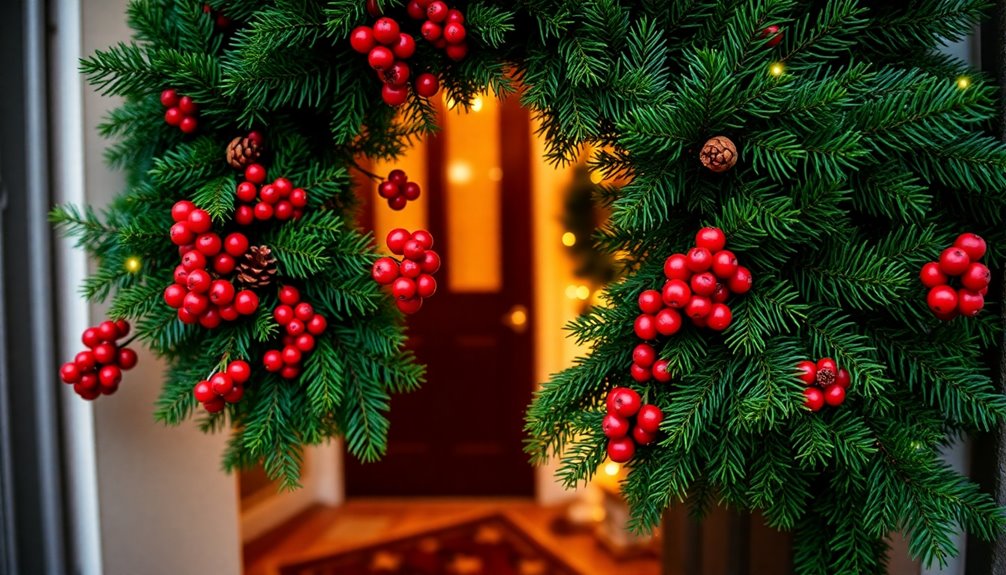A wreath on your door symbolizes warmth, hospitality, and the cyclical nature of life, connecting you to longstanding traditions. Its circular shape represents eternity, while evergreens remind you of resilience during winter. Across cultures, wreaths have marked celebrations like Christmas and New Year, often made from local flora for authenticity. They evoke feelings of joy, enhancing the festive spirit in your home and welcoming guests with a sense of community. Whether handcrafted or store-bought, wreaths reflect personal style and heritage in your decor. If you're curious about specific cultural meanings and designs, there's much more to explore.
Key Takeaways
- A wreath on the door symbolizes welcome and hospitality, inviting guests into the home during festive occasions.
- The circular shape signifies eternity and the cyclical nature of life, enhancing the spirit of the holiday season.
- Wreaths made from evergreens represent resilience and renewal, reflecting nature's endurance through winter.
- Different cultural wreath designs convey unique meanings, promoting community connections and celebrating cultural heritage.
- Wreaths evoke feelings of joy and nostalgia, enhancing the festive atmosphere and creating a sense of belonging during holidays.
Historical Origins of Wreaths
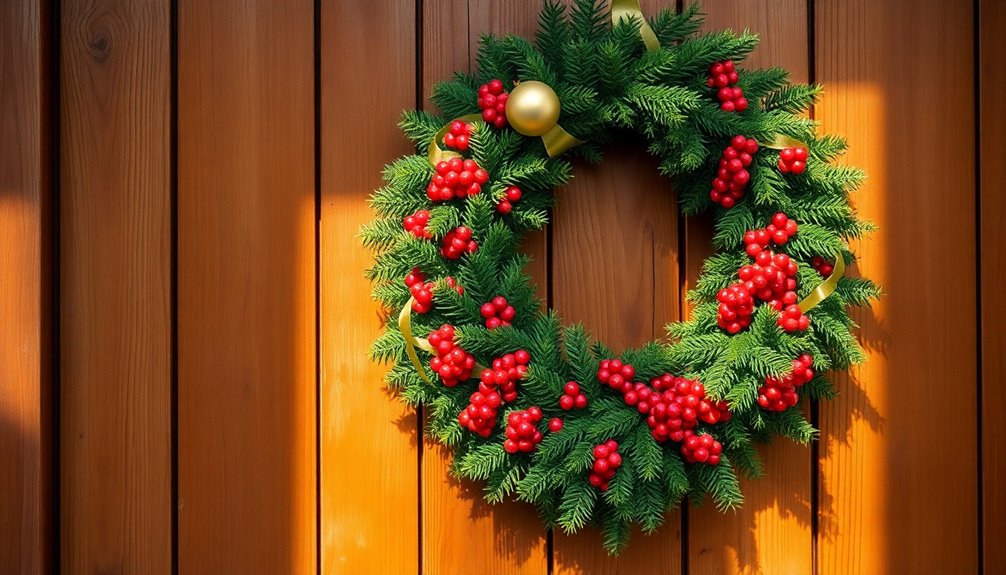
Wreaths have a rich history that intertwines with various cultures and traditions. The word "wreath" comes from the Old English term "writhen," which means to twist or coil, emphasizing their circular nature.
Dating back to ancient traditions, Greeks awarded laurel wreaths to symbolize honor and victory, especially in the Olympics. Romans wore wreaths as crowns to signify military triumphs and used them in celebrations, showcasing social status.
Early Christians embraced wreaths as symbols of eternal life, using their shape to represent eternity and faith's everlasting nature.
Symbolism of Wreaths

Throughout history, the significance of wreaths has evolved, reflecting various meanings across cultures. Wreaths symbolize continuity of life and nature, with evergreens representing resilience during winter. Their circular shape embodies eternity, reminding you of the cyclical nature of seasons and the promise of everlasting life. In the context of Advent, each candle in an Advent wreath signifies hope, peace, joy, and love, enhancing the spirit of Christmas. Additionally, traditional holly and red berries within the wreath connect to Christian symbolism, representing Christ's crown of thorns and blood. By hanging a wreath on your door, you're inviting joy and goodwill, fostering a warm atmosphere during the holiday season.
| Symbolism | Meaning |
|---|---|
| Circular Shape | Eternity and Infinity |
| Evergreens | Resilience and Renewal |
| Advent Candles | Hope, Peace, Joy, Love |
| Holly and Berries | Christ's Sacrifice |
| Warm Invitation | Spirit of Hospitality |
Cultural Significance of Wreaths
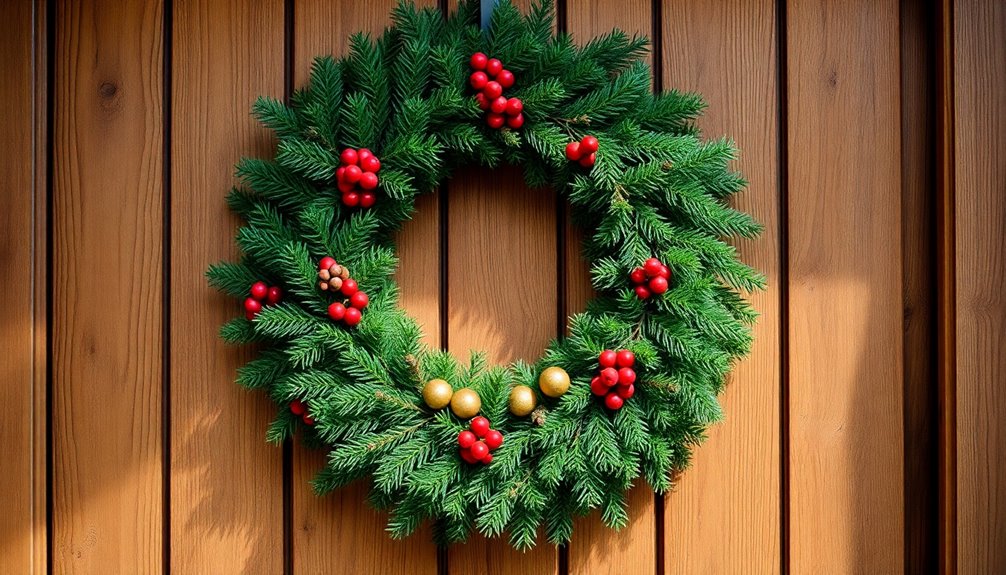
Wreaths have deep historical roots in various cultures, symbolizing victory and life cycles.
Today, you'll find them adorning doors during the holiday season, representing warmth and hospitality.
As you explore different traditions, you'll discover how these circular decorations embody unique meanings across cultures.
Historical Origins of Wreaths
While many view wreaths as simple decorations, their historical origins reveal a rich tapestry of cultural significance. Wreaths were used in ancient cultures like Greece and Rome to symbolize honor, victory, and status.
The circular nature of wreaths represents eternity, mirroring the cyclical patterns of life and the changing seasons. Early Christians adopted wreaths to signify eternal life, with evergreens embodying hope and resilience during the winter months. Additionally, the use of natural materials in wreath-making reflects a connection to the environment, much like the principles seen in Balinese architecture which emphasize harmony with nature.
Modern Wreath Traditions
In many cultures, wreaths have evolved into vibrant symbols of community and celebration. You'll find wreath-making activities bringing people together, fostering connections while embracing cultural traditions.
During the Advent season, many hang Christmas wreaths adorned with candles, each representing hope, peace, joy, and love.
In Scandinavian countries, wreaths play an essential role in winter solstice celebrations, symbolizing the return of light and the cycle of the seasons.
In Ukraine, the "Didukh" made from wheat pays homage to ancestors, blending agricultural roots with spiritual significance.
As you participate in these modern wreath traditions, you're not just decorating your door; you're inviting joy and goodwill into your home, connecting with a rich tapestry of cultural heritage.
Symbolism Across Cultures
When you hang a wreath on your door, you're participating in a tradition that spans numerous cultures, each imbuing this simple decoration with deep significance.
Here are three key cultural meanings:
- Ancient Rome: Wreaths became symbols of honor and status, often used in celebrations and victories.
- Germany: The Advent wreath, adorned with candles, represents the anticipation of Christmas, playing a crucial role in holiday traditions.
- Ukraine: The "Didukh," a sheaf of wheat, serves as a wreath-like symbol, linking ancestors to the harvest.
Additionally, wreaths can be crafted using natural materials to enhance their connection to seasonal themes and the environment.
Whether it's a festive Christmas wreath or a vibrant display in Mexico, each wreath on your front door invites guests, spreading warmth and cheer, reflecting the rich tapestry of cultural significance woven through time.
Modern Wreath-Making Techniques
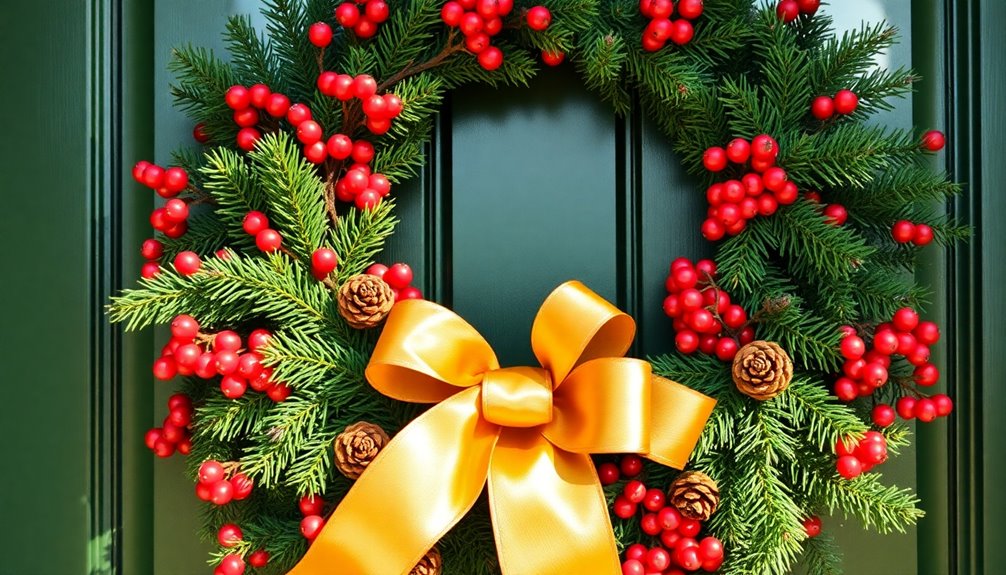
When you start making a modern wreath, choosing the right base material is essential for both aesthetics and longevity.
You can seamlessly integrate decorative elements like ribbons or dried fruits to showcase your personal style.
This hands-on approach not only enhances your creativity but also connects you to the timeless tradition of wreath-making.
Base Material Selection
Choosing the right base material for your wreath is essential, as it sets the foundation for your design. Here are three popular options to take into account:
- Wire – Provides a sturdy structure for holding decorations.
- Grapevine – Offers a rustic aesthetic and pairs beautifully with natural accents.
- Wood – Adds a solid base that complements evergreens and dried flowers.
Using fresh evergreens like pine, fir, and cedar guarantees durability and vibrant color, enhancing your wreath's visual appeal. You can wire small bunches of these evergreens together for a lush look. Additionally, incorporating dried flowers, pinecones, and seasonal berries can deepen your wreath's connection to holiday traditions, resulting in stunning wreaths made to celebrate the season. This combination of natural materials reflects the key elements of modern farmhouse style that emphasize rustic charm and functionality.
Decorative Element Integration
After selecting the perfect base material for your wreath, it's time to explore how to integrate decorative elements that elevate your design.
In the history of the Christmas tradition, wreaths were made using fresh evergreens, but today, you can enhance your creations by incorporating unique elements like dried lavender, roses, and orange slices. These additions not only promote sustainability but also add texture and visual interest.
You might also use natural accents like pinecones and berries to create rustic charm.
Don't forget those decorative touches—ribbons, bows, and ornaments personalize your wreaths, allowing you to express your style.
Materials Used in Wreaths

Wreaths come to life with a variety of materials that not only enhance their beauty but also imbue them with rich symbolism.
Here are three key components often used:
- Evergreens: Pine, fir, and cedar symbolize endurance, staying vibrant during the winter solstice.
- Holly and Ivy: Holly's red berries represent Christ's blood, while ivy signifies faithfulness and resilience.
- Herbs and Accents: Dried rosemary adds fragrance, and seasonal accents like pinecones and red berries symbolize abundance and fertility.
Wreaths in Holiday Celebrations
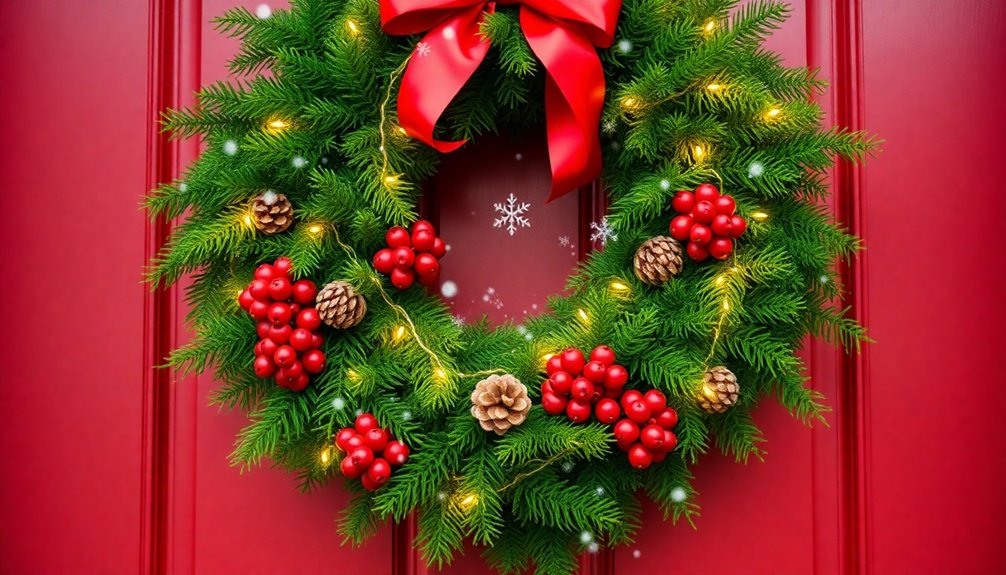
The beauty of wreaths extends beyond their materials; they play a significant role in holiday celebrations around the world. These circular symbols of eternity invite goodwill and warmth into your home, reflecting themes of renewal and hope.
Traditionally made from evergreens, wreaths symbolize resilience and the continuity of life, reminding you of nature's endurance even in winter's chill. In many cultures, wreaths signify connection and hospitality, often showcasing personal or cultural heritage during festive times.
Advent wreaths, adorned with four candles representing hope, peace, joy, and love, mark the weeks leading to Christmas in Christian traditions. Embracing wreaths in your holiday celebrations can enhance the sense of joy and unity that this season brings.
Frequently Asked Questions
What Is the Significance of a Wreath on a Door?
A wreath on your door signifies warmth and welcome, inviting friends and family to enter. It represents continuity, hope, and the cyclical nature of life, reminding you that even in winter's chill, life persists.
The circular shape embodies unity, while elements like holly and ivy symbolize resilience and renewal.
What Does the Wreath Symbolize in Christmas Tradition?
Did you know that over 90% of Americans display holiday decorations? A wreath on your door during Christmas symbolizes more than just festivity; it embodies welcome and goodwill.
Its circular shape reflects eternity and unity, inviting warmth into your home. Traditionally crafted from evergreens, it signifies resilience and hope during winter.
The Advent wreath, with its four candles, highlights the anticipation of joy, peace, love, and hope in the weeks leading to Christmas.
What Does "Placed a Wreath Upon His Door" Mean?
When you place a wreath upon your door, it's more than just decoration; it's a gesture of welcome and warmth. This act invites friends and family into your home, signaling joy and celebration.
The circular shape represents unity and continuity, reflecting your hope for togetherness during festive times. By hanging that wreath, you're embracing resilience and sharing a spirit of community, creating a festive atmosphere that resonates with those who pass by.
Why Do People Put Wreaths on Their Door at Christmas?
You put wreaths on your door at Christmas to create a welcoming atmosphere. They invite friends and family into your home, spreading joy and warmth during the festive season.
The circular shape symbolizes unity and eternity, reflecting the importance of togetherness. Made from evergreens, wreaths remind you of resilience and renewal, even in winter's chill.
Conclusion
As you hang a wreath on your door, imagine the vibrant greenery and colorful ornaments weaving together stories of love, hope, and celebration. Each twist of the ribbon and glimmer of a bauble reflects the warmth of holiday traditions, inviting friends and family to gather around. This simple act transforms your home into a sanctuary of joy, where the sweet scent of pine mingles with laughter, reminding you that the spirit of the season is alive and well.
